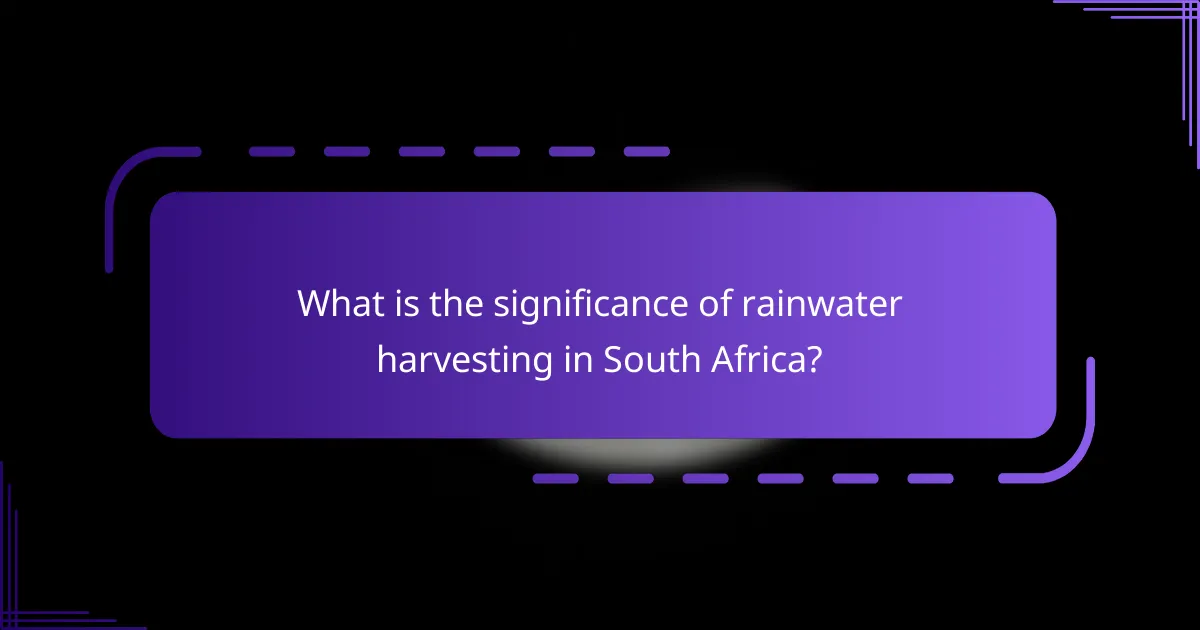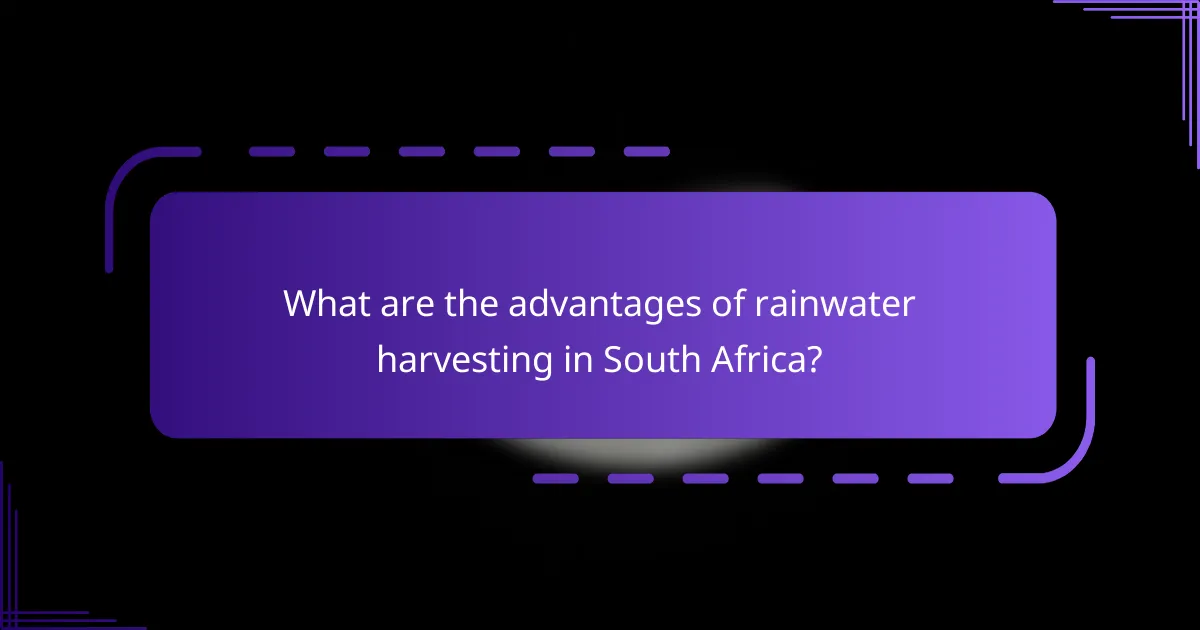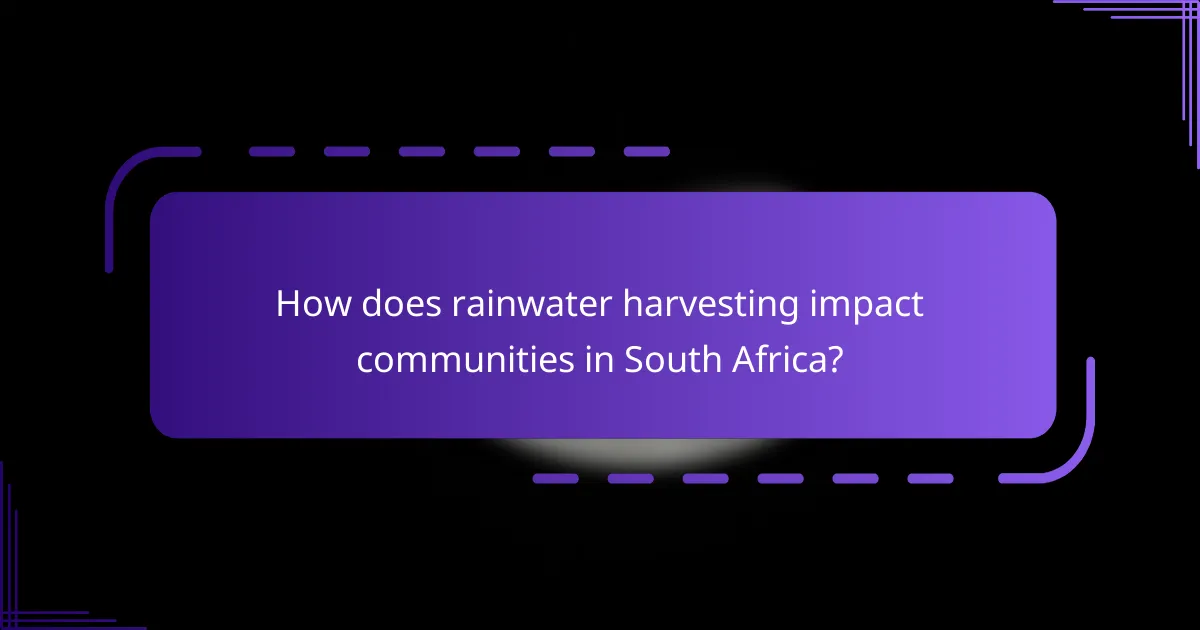Rainwater harvesting is a crucial practice in South Africa aimed at enhancing water security amid significant water scarcity and unpredictable rainfall patterns. This method serves as an alternative water source for domestic and agricultural use, reducing dependence on municipal water systems and lowering household water bills. Additionally, rainwater harvesting promotes sustainable water management, conserves groundwater resources, and mitigates flooding by capturing excess rainwater. The implementation of rainwater systems positively impacts communities, particularly in rural areas, by increasing access to clean water and fostering resilience and self-sufficiency. Overall, this practice supports environmental stewardship and improves water quality, making it an essential strategy in addressing the country’s water challenges.

What is the significance of rainwater harvesting in South Africa?
Rainwater harvesting is significant in South Africa due to its ability to enhance water security. The country faces severe water scarcity and unpredictable rainfall patterns. Collecting rainwater helps mitigate these challenges. It provides an alternative water source for domestic and agricultural use. This practice reduces reliance on municipal water systems. Rainwater harvesting can also lower water bills for households. Additionally, it promotes sustainable water management practices. According to the South African Department of Water and Sanitation, implementing rainwater harvesting can significantly alleviate water shortages in urban and rural areas.
How does rainwater harvesting contribute to water security?
Rainwater harvesting enhances water security by capturing and storing rainwater for future use. This method reduces dependence on traditional water sources, which may be unreliable. It provides an alternative water supply during droughts or dry seasons. According to the South African Department of Water and Sanitation, rainwater harvesting can significantly supplement municipal water supplies. This practice also helps recharge groundwater levels, contributing to long-term water availability. By utilizing local rainfall, communities can improve resilience against water scarcity. Studies show that effective rainwater harvesting can meet up to 50% of a household’s water needs in some regions. Therefore, it plays a crucial role in ensuring sustainable water resources.
What are the challenges faced in water supply in South Africa?
South Africa faces significant challenges in water supply. These include water scarcity due to prolonged droughts and climate change. Aging infrastructure leads to substantial water loss through leaks. Pollution from industrial and agricultural activities contaminates water sources. Inequitable distribution results in some communities lacking access to clean water. Economic constraints hinder investment in water management systems. Population growth increases demand for limited water resources. Lastly, inadequate governance and management practices exacerbate existing issues.
How does rainwater harvesting address these challenges?
Rainwater harvesting addresses water scarcity and quality challenges by capturing and storing rainwater for various uses. This method reduces reliance on municipal water supplies, especially in drought-prone areas. It improves water availability during dry seasons, ensuring a consistent supply for agriculture and domestic use. Additionally, it enhances groundwater recharge, which is crucial for maintaining local aquifers. A study by the Water Research Commission of South Africa indicates that rainwater harvesting can significantly supplement household water needs. This practice also helps mitigate flooding by controlling runoff, thus reducing erosion and water pollution.
What are the various methods of rainwater harvesting used in South Africa?
The various methods of rainwater harvesting used in South Africa include rooftop collection, surface runoff harvesting, and underground storage. Rooftop collection involves installing gutters and tanks to capture rainwater from building roofs. Surface runoff harvesting captures rainwater from land surfaces, directing it into storage systems. Underground storage systems, such as aquifers, store rainwater for later use. These methods help improve water availability in regions facing water scarcity. According to the South African National Water Act, rainwater harvesting is encouraged as a sustainable water management practice.
What are the traditional methods of rainwater harvesting?
Traditional methods of rainwater harvesting include surface runoff collection, rooftop catchment, and subsurface storage. Surface runoff collection involves directing rainwater from land surfaces into storage systems. Rooftop catchment systems utilize roofs to collect rainwater, which is then channeled into storage tanks. Subsurface storage methods include digging trenches or pits to capture and store rainwater underground. These techniques have been used for centuries in various cultures. They are particularly effective in regions with seasonal rainfall. Historical evidence shows that communities in South Africa have relied on these methods for sustainable water supply.
How do modern techniques enhance rainwater harvesting efficiency?
Modern techniques enhance rainwater harvesting efficiency through advanced collection and filtration systems. These systems utilize improved materials, such as high-density polyethylene, which increase durability and reduce leakage. Smart technology, including sensors and automated controls, optimizes water collection based on weather forecasts. Data analytics can predict rain patterns, allowing for better planning and storage. Rain gardens and permeable pavements enhance infiltration, maximizing the amount of water captured. Studies indicate that these innovations can increase water capture rates by up to 40%. Additionally, community education programs promote best practices, further improving overall system efficiency.

What are the advantages of rainwater harvesting in South Africa?
Rainwater harvesting in South Africa offers several advantages. It provides an alternative water source, reducing reliance on municipal supply. This method helps to conserve groundwater resources, which are under significant stress. Rainwater harvesting can mitigate flooding by capturing excess rainwater. It is also cost-effective, as it lowers water bills for households and businesses. The practice promotes sustainable water use in agriculture, enhancing crop production. Additionally, it improves water quality by filtering rainwater before use. These benefits contribute to better water security in a region facing climate variability.
How does rainwater harvesting benefit households and communities?
Rainwater harvesting benefits households and communities by providing a sustainable water source. It reduces dependence on municipal water supplies. This practice lowers water bills for families. Harvested rainwater can be used for irrigation, reducing costs for gardening and farming. It also helps manage stormwater runoff, mitigating flooding risks. Communities can utilize stored rainwater during droughts, enhancing water security. Additionally, rainwater harvesting promotes environmental sustainability by conserving groundwater resources. Studies show that this method can increase water availability in arid regions, improving overall community resilience.
What financial savings can be achieved through rainwater harvesting?
Rainwater harvesting can lead to significant financial savings for households and businesses. By capturing and utilizing rainwater, users can reduce their reliance on municipal water supply. This decreases water bills, especially in areas with high water tariffs. Additionally, rainwater harvesting systems can lower costs associated with landscaping and irrigation. According to a study by the Water Research Commission in South Africa, households can save up to 50% on water costs annually. Furthermore, installation of rainwater systems may qualify for government incentives or rebates, enhancing overall savings. These financial benefits make rainwater harvesting an economically viable option for many.
How does rainwater harvesting contribute to environmental sustainability?
Rainwater harvesting contributes to environmental sustainability by reducing reliance on traditional water sources. It captures and stores rainwater for various uses, decreasing the demand for groundwater and surface water. This practice helps to conserve natural water bodies. It also minimizes stormwater runoff, which can lead to erosion and water pollution. By utilizing rainwater, communities can decrease their carbon footprint associated with water transportation and treatment. According to the Water Research Commission of South Africa, implementing rainwater harvesting can reduce urban flooding and improve local water quality. This sustainable approach supports biodiversity by maintaining local ecosystems and reducing the stress on freshwater resources.
What role does rainwater harvesting play in agriculture?
Rainwater harvesting plays a crucial role in agriculture by providing an alternative water source for irrigation. It helps to conserve water and reduce dependency on traditional sources. This method captures and stores rainwater for later use, especially during dry periods. Studies show that rainwater harvesting can increase crop yields by up to 50%. It also enhances soil moisture retention, promoting healthier plant growth. Furthermore, it reduces soil erosion and runoff, improving land quality. This practice is particularly beneficial in arid and semi-arid regions, where water scarcity is a significant challenge.
How can rainwater harvesting improve crop yields?
Rainwater harvesting can significantly improve crop yields by providing a reliable water source during dry periods. This method captures and stores rainwater for irrigation, ensuring crops receive adequate moisture. Enhanced soil moisture levels lead to better seed germination and growth rates. Studies show that crops irrigated with harvested rainwater can yield 20-30% more compared to those relying solely on traditional water sources. Additionally, rainwater harvesting reduces dependency on groundwater, which can be over-exploited. Implementing this practice supports sustainable agriculture and improves food security in regions prone to drought.
What are the long-term impacts of rainwater harvesting on soil health?
Rainwater harvesting positively impacts soil health in the long term. It enhances soil moisture retention. Improved moisture levels promote better plant growth. Increased vegetation leads to improved soil structure. Enhanced soil structure reduces erosion and runoff. This process enriches soil organic matter over time. Higher organic matter levels improve nutrient availability. Studies show that rainwater harvesting can increase soil fertility by up to 30%. This ultimately supports sustainable agricultural practices.

How does rainwater harvesting impact communities in South Africa?
Rainwater harvesting positively impacts communities in South Africa by enhancing water security. It provides a sustainable water source during droughts, reducing reliance on municipal supplies. This method helps mitigate water scarcity, especially in rural areas. Communities can use harvested rainwater for drinking, irrigation, and sanitation. Studies indicate that rainwater harvesting can increase access to clean water by up to 30%. Additionally, it promotes self-sufficiency and resilience among communities. Implementing rainwater systems can also lead to cost savings on water bills. Overall, it fosters community engagement and environmental stewardship.
What social benefits arise from implementing rainwater harvesting systems?
Implementing rainwater harvesting systems provides significant social benefits. These systems enhance community resilience to water scarcity. They promote sustainable water management practices. Improved access to water leads to better health outcomes. Communities experience reduced water costs, benefiting low-income households. Rainwater harvesting fosters community engagement and cooperation. It encourages local employment opportunities in installation and maintenance. Overall, these systems contribute to social equity and environmental awareness.
How does rainwater harvesting foster community collaboration?
Rainwater harvesting fosters community collaboration by encouraging collective participation in water management. It brings neighbors together to share resources and knowledge. Community members often work together to install and maintain rainwater harvesting systems. This collaboration enhances social bonds and trust among residents. Educational workshops on rainwater harvesting promote awareness and skill-sharing. Local governments and organizations frequently support community-based initiatives, increasing engagement. Successful projects often lead to shared benefits, such as improved water access and sustainability. These collaborative efforts can strengthen community resilience against water scarcity.
What educational opportunities does rainwater harvesting create?
Rainwater harvesting creates educational opportunities by promoting environmental awareness and sustainability. It serves as a practical tool for teaching about water conservation. Schools and communities can implement workshops on rainwater collection techniques. These programs can cover the science of the water cycle and the importance of water management. Students learn about the impact of climate change on water resources. Rainwater harvesting projects can also encourage hands-on learning experiences. This fosters critical thinking and problem-solving skills. Research has shown that educational initiatives in this area enhance community engagement and stewardship.
What are the barriers to rainwater harvesting adoption in South Africa?
Barriers to rainwater harvesting adoption in South Africa include regulatory challenges, high initial costs, and lack of public awareness. Regulatory challenges stem from unclear policies and guidelines, which hinder implementation. High initial costs for installation and equipment deter potential adopters. Additionally, many communities lack awareness of the benefits and feasibility of rainwater harvesting. Research indicates that these barriers significantly limit widespread adoption, impacting water security in the region.
What are the common misconceptions about rainwater harvesting?
Rainwater harvesting is often misunderstood. One common misconception is that it is illegal. In many regions, including South Africa, it is legal and encouraged. Another misconception is that harvested rainwater is unsafe for drinking. In reality, with proper filtration and treatment, it can be safe. Some believe that rainwater harvesting requires significant investment. However, many low-cost systems are effective. Additionally, people often think rainwater harvesting is only for rural areas. Urban environments can also benefit significantly. Lastly, there is a belief that rainwater harvesting cannot meet water needs. In fact, it can supplement municipal water supplies effectively.
How can policy changes facilitate wider adoption of rainwater harvesting?
Policy changes can facilitate wider adoption of rainwater harvesting by providing financial incentives and regulatory frameworks. Financial incentives, such as tax rebates or grants, lower the initial investment costs for households and businesses. Regulatory frameworks can mandate rainwater harvesting systems in new constructions, ensuring compliance and standardization. Additionally, educational programs funded by policy initiatives can raise public awareness about the benefits of rainwater harvesting. Studies show that areas with supportive policies see a higher implementation rate of rainwater harvesting systems. For instance, in Australia, government subsidies led to a significant increase in residential rainwater tanks. Thus, effective policy changes can create an environment that encourages and supports rainwater harvesting practices.
What are best practices for effective rainwater harvesting in South Africa?
Effective rainwater harvesting in South Africa involves several best practices. First, proper system design is crucial. This includes selecting appropriate catchment surfaces, such as roofs. Second, using high-quality storage tanks is essential. Tanks should be made of durable materials to prevent contamination. Third, regular maintenance of the system is necessary. This includes cleaning gutters and checking for leaks.
Implementing filtration systems can improve water quality. Filters remove debris and contaminants before water enters storage. Additionally, using first-flush diverters is recommended. These devices ensure that the initial dirty runoff is excluded from storage tanks.
Educating the community about rainwater harvesting is vital. Awareness programs can increase participation and proper usage. Lastly, complying with local regulations ensures that the systems are safe and effective. Following these best practices can enhance the efficiency of rainwater harvesting in South Africa.
How can individuals optimize their rainwater harvesting systems?
Individuals can optimize their rainwater harvesting systems by ensuring proper system design and maintenance. A well-designed system includes adequate sizing of storage tanks based on rainfall patterns. Regular cleaning of gutters and filters prevents debris from contaminating the water. Using first-flush diverters improves water quality by discarding the initial runoff. Implementing a pump system enhances water distribution efficiency. Monitoring water levels helps manage usage effectively. Additionally, incorporating water-efficient appliances reduces overall demand. These practices collectively enhance the system’s effectiveness and sustainability in water conservation efforts.
What maintenance tips are essential for successful rainwater harvesting?
Regularly clean gutters and downspouts to prevent debris buildup. This ensures efficient water flow into the harvesting system. Inspect and maintain the storage tank for leaks and structural integrity. Proper tank maintenance prevents contamination and ensures water quality. Use filters to remove sediment and debris before water enters the tank. This practice enhances the purity of collected rainwater. Periodically check and clean filters to maintain their effectiveness. Monitor water levels and usage to optimize harvesting efficiency. Implement a first-flush system to divert initial runoff, which may contain pollutants. Following these maintenance tips can significantly improve the success of rainwater harvesting systems.
Rainwater harvesting is a crucial practice in South Africa, addressing significant water scarcity challenges and enhancing water security. This article explores various methods of rainwater harvesting, including rooftop collection and underground storage, and highlights its advantages such as reduced reliance on municipal water, cost savings, and improved agricultural yields. It also examines the social and environmental impacts of rainwater harvesting on communities, emphasizing its role in promoting sustainability and resilience against climate variability. Furthermore, the article discusses barriers to adoption, misconceptions, and best practices for optimizing rainwater harvesting systems.